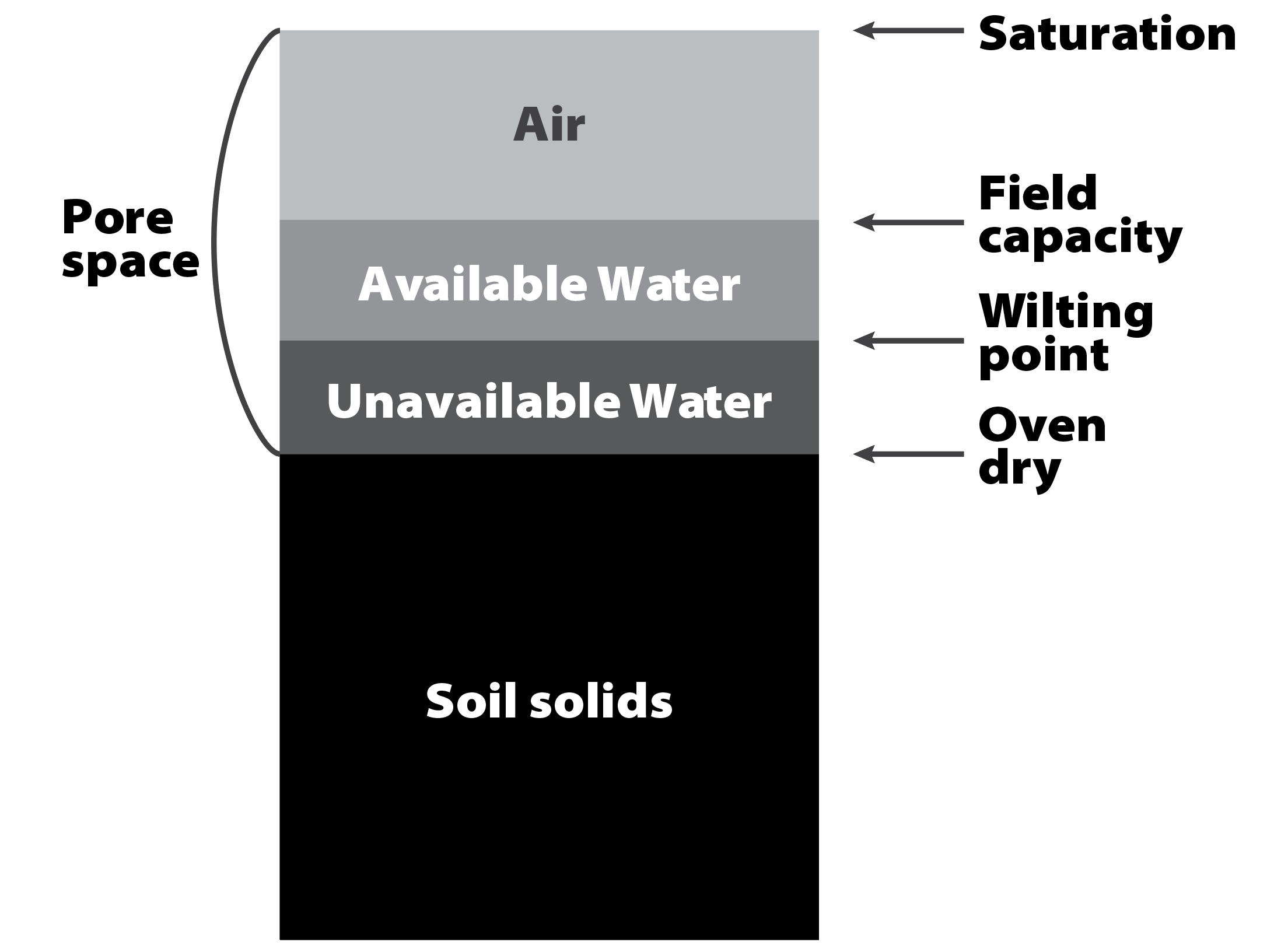Soil Physical Properties in Healthy Soils
Soil health is the continued capacity of soil to function as a vital living ecosystem that sustains plants, animals, and humans. Soil provides many benefits:
- Regulates water, whether it infiltrates and percolates, is lost by runoff, or is added by irrigation;
- Sustains plant and animal life;
- Filters and buffers pollutants;
- Cycles nutrients; and
- Provides physical support and stability for plants and humans.
Thriving biological communities are essential to soil’s ability to provide these services. Just as good working environments improve human productivity, good working environments foster soil biology and healthy soils. The physical makeup of soils provides this environment. Soils contain mineral solids or separates, organic matter solids, water, and air. The solids originate from geological weathering and the residues of formerly living organisms. Water and air are naturally present and cycle through soils.
This publication defines and provides context of soil physical properties for nonscientists. More detailed information is available in the Glossary of Soil Science Terms.

- Aggregation refers to soil aggregates, or arrangements or groups of the solid soil particles that stick to each other strongly through organic matter and particle associations.
- Aggregate stability is a measurement of the proportion of those aggregates that do not easily dissociate or disintegrate. Better aggregate stability is an indicator of soil health. Aggregate stability can be improved through minimal tillage or no-till, which reduces the physical breaking apart of aggregates. Reducing tillage should increase biological activity in the soil and thus increase the organic matter that acts as the “glue” to bind aggregates.
- Field capacity is the water remaining in soil 2 or 3 days after it has been thoroughly watered with negligible free drainage.
- Available soil water is the amount of water between “field capacity” and “permanent wilting point,” or the amount of water stored in the soil that is available for use by plants. The actual amount of water plants will use depends on the plant species. The upper and lower soil water content over which water, oxygen, and mechanical resistance do not restrict plant growth is called the “nonlimiting water range.” See Figure 1.
- Wilting point, or permanent wilting point, is the water content of a soil at which growing plants wilt and fail to recover.
- Unavailable water is the water remaining in the soil after the wilting point is reached.
- Bulk density is a measure of dry weight of soil per unit of volume that reflects the soil’s functionality. Bulk density affects water infiltration and storage capacity, effective rooting zones (zones of available nutrients), and microbial activity. Bulk density indicates the level of compaction and is usually measured in cores of undisturbed samples extracted from the soil.
- Compaction provides information about leaching potential and erosion as water is restricted from moving through the soil. Compacted soil may divert water, causing runoff that removes soil and nutrients bound to it. Compaction also restricts root development, decreasing the volume of soil that can provide nutrients to plants.
- Soil Color is determined by the solids in the soil and organic matter content. Soils come in a wide range of colors that may be classified using color charts. Color does not affect soil behavior or potential uses; however, color does provide evidence of the conditions in which the soil developed and hints of its composition.
- Hydraulic conductivity/saturated hydraulic conductivity describes how fast water can move through soil pores. Hydraulic conductivity can be used to compare the permeability of different soils.
- Infiltration is the process by which water on the surface enters the soil.
- Porosity refers to the volume of pores, or open spaces, in a soil sample (the nonsolid volume) divided by the bulk volume of the sample. The bulk or total volume contains both mineral and organic solids and open pore spaces that are filled by either air or water. Larger soil organisms such as earthworms, ants, and termites create large pores that may influence soil structure. Compacted soils have lower porosity and greater bulk density, while looser soils have more porosity and lower bulk density.
- Macropores are large soil pores usually found between aggregates; they are typically greater than 0.08 mm in diameter. Macropores originate from biological activity such as earthworms or roots, shrink-swell cracks, or mechanical forces. They are key in determining infiltration rates and potentially move large amounts of water and dissolved solutes deeper into the soils.
- Micropores are small soil pores inside soil aggregates that hold water and solutes. Movement away from micropores is chiefly via diffusion.
- Percolation occurs when water moves downward through soils.
- Structure refers to the combination or arrangement of soil aggregates and primary soil particles. The secondary units are characterized based on size, shape, and their degree of distinctness. Structure has a strong influence on water and air movement in the soil, root penetration, and nutrient availability to plants.
- Texture is determined by the proportions of the soil separates (solid particles) in a soil. The solids are sand, silt, or clay. Sand particles are large (larger than 0.05 mm), silt particles are intermediate (0.05 to 0.002 mm), and clay particles are tiny (less than 0.002 mm). Texture determines the type of soil and its natural limitations for drainage, water-holding capacity, aeration, erosion susceptibility, nutrient cycling, and pH buffering. Soil textures are permanent products of geological weathering and cannot be altered. Soil management practices can be targeted based on soil textures to optimize economic and environmental outcomes.
- Tilth is the physical condition of soil as related to its ease of tillage, fitness as a seedbed, and impedance to seedling emergence and root penetration. There is no standard measurement for tilth.
These properties affect soil biology, soil health, and crop development. The relationship of texture, aggregation, and structure has enormous influence on root development and how water and air move in the soil. Soil management to improve those properties includes keeping soil covered as much as possible with growing plants while minimizing tillage. Using rotations with higher residue crops and cover crops will have positive effects. Manure or biosolid land applications will add organic matter and should increase soil biological activity and improve soil physical properties.
References
Norris, C. E., et al. (2020). Introducing the North American project to evaluate soil health measurements. Agronomy Journal, 112(4), 3195-3215.
Rogers, D. H., et al. (2015). Important agricultural soil properties. In Biological and agricultural engineering (Irrigation Management, pp. 8). Kansas State University Agricultural Experiment Station and Cooperative Extension Service.
Soil Science Society of America. (2008). Glossary of soil science terms (ASA, CSSA, and SSSA Books). Madison, WI: Soil Science Society of America, Inc.
Publication 3660 (POD-06-24)
Reviewed by Corey Bryant, PhD, Assistant Professor, Delta Research and Extension Center. Written by J. Larry Oldham, PhD, Extension Professor (retired), Plant and Soil Sciences.
The Mississippi State University Extension Service is working to ensure all web content is accessible to all users. If you need assistance accessing any of our content, please email the webteam or call 662-325-2262.




